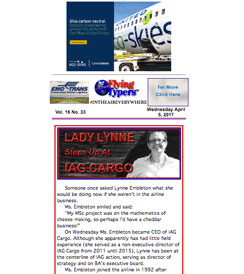
Prime Minister Narendra Modi with his Malaysian
counterpart Najib Razak looks on as External Affairs Minister Sushma
Swaraj and Malaysian Minister of Transport Dato’ Sri Liow Tiong
Lai exchange documents at Hyderabad House in New Delhi. |
The recent six-day
visit of Malaysian Prime Minister Najib Tun Razak to India came at an
opportune moment: this year marks the 60th anniversary of India-Malaysia
diplomatic relations and emphasizes the success of India’s Look
East, Act East policy.
Good
Timing For FIATA
For air & ocean cargo
watchers, the timing is perfect. The
FIATA World Congress, the world’s premier freight forwarding
conference, begins October 4 in Kuala Lumpur, bringing the world to Malaysia’s
doorstep.
What’s more, next year’s FIATA
World Congress (2018) will be held in India.
Opportunities are ripe for development
with India and Malaysia center stage at the next two FIATA World Congress
gatherings.
Malaysia
& India Upswing
Incidentally, in 2015, Prime Minister Narendra Modi paid an official visit
to Malaysia that led to the establishment of an ‘enhanced strategic
partnership’ between the two nations.
What is, perhaps, more notable is that
this year is also the 25th anniversary of the India-ASEAN (Association
of Southeast Asian Nations) dialogue partnership.
It was important for India to have a dialogue
and build relations with one of the foremost ASEAN members. Since Prime
Minister Modi is a strong advocate of economic diplomacy, the prime focus
of Prime Minister Razak’s visit was to strengthen economic ties
with India.
 The
Joint Is Jumping The
Joint Is Jumping
The Joint Statement of the India-Malaysia CEOs Forum pointed out that
Malaysia was India’s third largest trading partner in ASEAN. Bilateral
trade between Malaysia and India stood at U.S. $12.8 billion in 2015-16,
against U.S. $16.9 billion in 2014-15. The trade balance was in favor
of Malaysia (U.S. $5.4 billion in 2015-16) and the two prime ministers
hoped to see trade increase to U.S. $15 billion in the immediate future.
Increasing
Trade
The
CEOs Forum also emphasized that one of the ways to increase trade would
be to improve and expand bilateral rights in aviation.
Malaysia maintains that the enhancement
of bilateral rights would also coincide with India’s focus on enhancing
air connectivity and hence the demand to review the Bilateral Air Services
Agreement between India and Malaysia to expand the number of slots for
airlines to operate between the two countries.
The Malaysian CEOs also emphasized that
Malaysian carriers could be given more rights, including travel to other
countries through India.
Mr.
X Marks The Spot
The Malaysian side also suggested—AirAsia Bhd. Executive Chairman
and AirAsia X Group Chief Executive Officer Datuk Kamarudin Meranun was
part of the delegation—that the Indian government waive off the
mandatory five-year rule for carriers to start flying overseas. If the
rules are liberalized, Air Asia India could fly overseas.
Liberalization of air services would mean
more services by Indian carriers to Malaysia and Southeast Asia and would
help enhance investment and economic growth between both countries.
“This,” said the statement,
“will generate greater economic contribution for both countries
via tourist arrivals, people to people communication, medical tourism,
education, infrastructure development, and socio-economic growth.”
New
Air Services Agreement
The Air Services Agreement (the last was signed 50 years ago in 1967)
that was signed would see a rise of around 2,000 additional seats for
Malaysia from India.
Transport Minister Datuk Seri Liow Tiong
Lai, who was part of the Prime Minister Datuk Seri Najib Tun Razak’s
delegation, said the extra seats were approved for the six cities of Chennai,
New Delhi, Kolkata, Mumbai, Bengaluru, and Hyderabad.
“With this, we can fly more Malaysians
into India and the other way around too.
“This will have a big impact on expanding
our tourism potential,” Liow was quoted saying.
He also said, “We are prepared to
be liberal with India in line with Asean’s Open Skies policy,”
he added.
Under India’s National Civil Aviation
Policy 2016, Liow said that for countries fully or partly within a 5,000
km. radius from New Delhi, extra air traffic rights could only be considered
if India’s airlines were able to use up at least 80 percent of their
entitlement.
India’s airlines’ present rate
of utilization to Malaysia was only about 5 percent.
Malaysian
Breakthrough & Think Tank
According to Liow, the new agreement is a breakthrough for the Malaysians.
There have been constant efforts to boost
air cargo between India and ASEAN nations.
Reportedly, Research and Information System
(RIS) for Developing Countries has been a major think tank espousing the
cause of air cargo to ASEAN nations.
Chaired by former Indian Foreign Secretary
Shyam Saran, the ASEAN-India Centre (AIC) at RIS prepared the ASEAN-India
Air Connectivity Report, which addressed the issues and challenges concerning
the air connectivity between India and ASEAN, especially relating to air
cargo that would help to unlock the trade potential of the region by removing
constraints and bottlenecks to growth.
ASEAN,
Make In India, & Skill India
The report came in the background of the “Make in India” and
“Skill India” programs for which stronger air connectivity
was an essential factor.
The report has mentioned that more airlines
in air cargo would boost trade between ASEAN and India and beyond.
Stronger air connectivity with Southeast
and East Asia would also provide a fillip to India’s “Make
in India” and “Skill India” initiatives.
The ASEAN constituted about 18 percent
of international freight flow from India and about 11 percent international
freight flow to India. With the exception of Thailand, all ASEAN countries
recorded a freight deficit with India in 2015. That meant India exported
more ‘weights’ than what it imported from ASEAN, and naturally
was paying more towards freight.
The study also recommended that since the
share of air cargo compared to other modes of cargo transportation was
fairly low in India, it was necessary to attract more cargo airlines from
Southeast and East Asia to boost the trade not only between India, but
also with the rest of the world.
ASEAN
In The Wings
Although the ASEAN Open Skies Policy in part came into effect on January
1, 2015, it was yet to be fully operational.
The ASEAN Single Aviation Market (ASAM)
would lead to growth and development as it opened up the market to more
competition.
Greater connectivity between aviation markets
arising from ASAM would encourage higher traffic flow and improve service
quality while lowering airfares.
The most important aspect of liberalizing
aviation markets was the guarantee of third, fourth, fifth, and seventh
freedoms of the air. If the additional air freedom right were given, opening
of ASAM would be advantageous to Indian carriers to fly to Southeast Asia
on a larger scale.
A comprehensive ASEAN-India Air Transport
Agreement (AIATA) is recommended to expand trade between ASEAN and India.
Tirthankar Ghosh
|




 The
Joint Is Jumping
The
Joint Is Jumping

